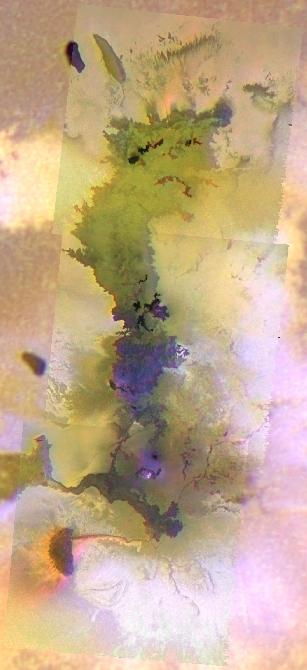

This mosaic combines data collected in February 2000 and the summer of 1999 by NASA's Galileo spacecraft to highlight new details of the longest active lava flow known in the Solar System. The mosaic is 500 kilometers (310 miles) long and 180 kilometers (110 miles) wide. Black and white images at 210 meters (690 feet) per picture element were combined with color data at 1.3 kilometers (0.8 miles) per picture element. This computer wizardry allows us to learn much more than either set of pictures by themselves.
The area around Amirani was known to be the home of a number of volcanic hot spot since NASA's two Voyager spacecraft flew by Jupiter in 1979. Images collected by the Galileo spacecraft in 1999 showed that these hot areas were part of a single immense lava flow field. The newest images confirm that the Amirani flow field is indeed a quiltwork of dark lava flows. The most recent lavas are the darkest because they are too hot to be covered by sulfur-dioxide plumes. Fresh lava is leaking out of at least 5 areas at the northern end of the Amirani flow field and at least 3 places in the middle. However, it is likely that the lava first comes to the surface near the southern end of the flow field. The liquid lava travels under a frozen layer of older lava, breaking out onto the surface only after traveling hundreds of kilometers (miles) from the vent. The "small" breakouts produce lava flows larger than the current eruption at Kilauea Volcano, Hawaii (Earth). These observations are helping to explain how ancient very large lava flows form on the Earth.
While the behavior of the lava once it is on the surface makes sense, how it comes to the surface is more complicated. Small white diffuse halos surrounding the darkest lava flows are probably sulfurdioxide-rich snows and frosts that have been vaporized by the hot lava. The bright red material to the south of the Amirani Flow Field is likely to contain a large fraction of sulfur droplets. Sulfur-rich gas appears to be bubbling out all along the east-west crack at the southern end of Amirani. This may be the crack along which the lava rises to the surface. The main Amirani plume appears to emanate from a fuzzy, purplish area within the southern part of the flow field. This is a plausible alternative location for the lava to be coming to the surface. Future observations are planned to help decipher the remaining mysteries of the largest known active lava flow in our solar system.
North is to the top of the image.
Image produced by: Moses Milazzo, Planetary Image Research Lab. (PIRL), Lunar and Planetary Lab. (LPL), University of Arizona
The Jet Propulsion Laboratory, Pasadena, CA manages the Galileo mission for NASA's Office of Space Science, Washington, DC. JPL is a division of the California Institute of Technology, Pasadena, CA.
This image and other images and data received from Galileo are posted on the World Wide Web, on the Galileo mission home page at http://galileo.jpl.nasa.gov/. Background information and educational context for the images can be found at http://galileo.jpl.nasa.gov/images/io/ioimages.html.
NASA's Planetary Photojournal PIA-02567
October 26, 2000